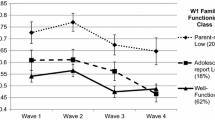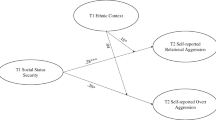Abstract
This study examines how multiple indicators of adolescent and parent acculturation relate to longitudinal trajectories of Latino adolescent aggression. The hierarchical linear modeling analysis is based on a final sample of 256 adolescents paired with one parent. Of the adolescents, 66% were born outside of the United States and the remaining 34% were US-born. Families lived in two sites: 38% lived in North Carolina and 62% lived in Arizona. The overall trajectory of Latino adolescent aggression displays a statistically significant negative trend best characterized by a quadratic curve. We delineate significant risk factors related to aggression levels, and show that gender, age, parent-reported acculturation conflicts, and adolescent-reported parent-adolescent conflicts are associated with higher levels of adolescent aggression. We discuss the study limitations, implications of the findings, and fertile ground for future research.


Similar content being viewed by others
References
Centers for Disease Control and Prevention (2006) Youth risk behavior surveillance-United States, 2005. Surveillance Summaries. MMWR 2006:55 (No. SS-5). Available from: http://www.cdc.gov/mmwr/PDF/SS/SS5505.pdf
Kaufman P, Chen X, Choy SP, Peter K, Ruddy SA, Miller AK et al (2001) Indicators of school crime and safety: 2001 (NCES 2002–113 or NCJ-190075). US Department of Education and US Department of Justice, Washington
Redfield R, Linton R, Herskovits M (1936) Memorandum for the study of acculturation. Am Anthropol 38:149–152. doi:10.1525/aa.1936.38.1.02a00330
Smith EP, Guerra NG (2006) Introduction. In: Guerra NG, Smith EP (eds) Preventing youth violence in a multicultural society. American Psychological Association, Washington, pp 3–14
Berry JW (1998) Acculturation stress. In: Balls Organista P, Chun KM, Marin G (eds) Readings in ethnic psychology. Routledge, New York, pp 117–122
Castro FG, Coe K, Gutierres S, Saenz D (1996) Designing health promotion programs for Latinos. In: Kato PM, Mann T (eds) Handbook of diversity issues in health psychology. Plenum, New York, pp 319–346
Cabassa LJ (2003) Measuring acculturation: where we are and where we need to go. Hisp J Behav Sci 25:127–146. doi:10.1177/0739986303025002001
Dahlberg LL, Krug EG (2002) Violence: a global public health problem. In: Krug EG, Dahlberg LL, Mercy JA, Zwi AB, Lozano R (eds) World report on violence and health. World Health Organization, Geneva, pp 1–21
Dinh KT, Roosa MW, Tein JY, Lopez VA (2002) The relationship between acculturation and problem behavior proneness in a Hispanic youth sample: a longitudinal mediation model. J Abnorm Child Psychol 30:295–309. doi:10.1023/A:1015111014775
Gonzales NA, Deardorff J, Formoso D, Barr A, Barrera M (2006) Family mediators of the relation between acculturation and adolescent mental health. Fam Relat 55:318–330. doi:10.1111/j.1741-3729.2006.00405.x
Smokowski PR, Bacallao ML (2006) Acculturation and aggression in Latino adolescents: a structural model focusing on cultural risk factors and assets. J Abnorm Child Psychol 34:657–671. doi:10.1007/s10802-006-9049-4
Vega WA, Gil AG, Warheit G, Zimmerman R, Apospori E (1993) Acculturation and delinquent behavior among Cuban American adolescents: toward an empirical model. Am J Community Psychol 21:113–125. doi:10.1007/BF00938210
Vega WA, Khoury E, Zimmerman R, Gil AG, Warheit G (1995) Cultural conflicts and problem behaviors of Latino adolescents in home and school environments. J Community Psychol 23:167–179. doi:10.1002/1520-6629(199504)23:2<167::AID-JCOP2290230207>3.0.CO;2-O
Bird H, Canino G, Davies M, Duarte C, Febo V, Ramirez R et al (2006) A study of disruptive behavior disorders in Puerto Rican youth: I. Background, design, and survey methods. J Am Acad Child Adolesc Psychiatry 45:1032–1041. doi:10.1097/01.chi.0000227879.65651.cf
Bird HR, Davies M, Duarte CS (2006) A study of disruptive behavior disorders in Puerto Rican youth: II. Baseline prevalence, comorbidity, and correlates in two sites. J Am Acad Child Adolesc Psychiatry 45:1042–1053. doi:10.1097/01.chi.0000227878.58027.3d
Smokowski PR, David-Ferdon C, Stroupe N (2009) Acculturation, youth violence, and suicidal behavior in minority adolescents: a review of the empirical literature. J Prim Prev (forthcoming)
Brook JS, Whiteman M, Balka EB, Win T, Gursen MD (1998) African American and Puerto Rican drug use: a longitudinal study. J Am Acad Child Adolesc Psychiatry 36:1260–1268
Bui H, Thongniramol O (2005) Immigration and self-reported delinquency: the interplay of immigration, generations, gender, race, and ethnicity. J Crim Justice 28:71–80
Buriel R, Calzada S, Vasquez R (1982) The relationship of traditional Mexican American culture to adjustment and delinquency among three generations of Mexican American male adolescents. Hisp J Behav Sci 4:41–55. doi:10.1177/07399863820041003
Samaniego RY, Gonzales NA (1999) Multiple mediators of the effects of acculturation status on delinquency for Mexican American adolescents. Am J Community Psychol 27:189–210. doi:10.1023/A:1022883601126
Sommers I, Fagan J, Baskin D (1993) Sociocultural influences on the explanation of delinquency for Puerto Rican youths. Hisp J Behav Sci 15:36–62. doi:10.1177/07399863930151002
Carvajal SC, Hanson CE, Romero AJ, Coyle KK (2002) Behavioural risk factors and protective factors in adolescents: a comparison of Latino and non-Latino whites. Ethn Health 7:181–193. doi:10.1080/1355785022000042015
Caetano R, Schafer J, Cunradi CB (2000) Intimate partner violence, acculturation and alcohol consumption among Hispanic couples in the United States. J Interpers Violence 15:30–45. doi:10.1177/088626000015001003
Markides K, Krause N, Mendes De Leon CF (1988) Acculturation and alcohol consumption among Mexican Americans: a three-generation study. Am J Public Health 78:1178–1181. doi:10.2105/AJPH.78.9.1178
Rogler LH, Cortes RS, Malgady RG (1991) Acculturation and mental health status among Hispanics. Am Psychol 46:585–597. doi:10.1037/0003-066X.46.6.585
Gil A, Wagner E, Vega W (2000) Acculturation, familism, and alcohol use among Latino adolescent males: longitudinal relations. J Community Psychol 28:443–458. doi:10.1002/1520-6629(200007)28:4<443::AID-JCOP6>3.0.CO;2-A
Gil AG, Vega WA, Dimas JM (1994) Acculturative stress and personal adjustment among Hispanic adolescent boys. J Community Psychol 22:43–54. doi:10.1002/1520-6629(199401)22:1<43::AID-JCOP2290220106>3.0.CO;2-T
Vega WA, Gil A, Warheit G, Apospori E, Zimmerman R (1993) The relationship of drug use to suicide ideation and attempts among African American, Hispanic, and white non-Hispanic male adolescents. Suicide Life Threat Behav 23:110–119
Decker MR, Raj A, Silverman JG (2007) Sexual violence against adolescent girls: influences of immigration and acculturation. Violence Against Women 13:498–513. doi:10.1177/1077801207300654
Silverman JG, Decker MR, Raj A (2007) Immigration-based disparities in adolescent girls’ vulnerability to dating violence. Matern Child Health J 11:37–43. doi:10.1007/s10995-006-0130-y
Hovey JD (1998) Acculturative stress, depression, and suicidal ideation among Mexican–American adolescents: implications for the development of suicide prevention programs in schools. Psychol Rep 83:249–250. doi:10.2466/PR0.83.5.249-250
Hovey JD, King CA (1996) Acculturative stress, depression, and suicidal ideation among immigrant and second-generation Latino adolescents. J Am Acad Child Adolesc Psychiatry 35:1183–1192. doi:10.1097/00004583-199609000-00016
Brown B, Benedict WR (2004) Bullets, blades, and being afraid in Hispanic high schools: an exploratory study of the presence of weapons and fear of weapons-related victimization among high school students in a border town. Crime Delinq 50:372–394. doi:10.1177/0011128703254916
Olvera RL (2001) Suicidal ideation in Hispanic and mixed ancestry adolescents. Suicide Life Threat Behav 31:416–427. doi:10.1521/suli.31.4.416.22049
Rasmussen K, Negy C, Carlson R, Burns J (1997) Suicide ideation and acculturation among low socioeconomic status Mexican American adolescents. J Early Adolesc 17:390–407. doi:10.1177/0272431697017004003
Sanderson M, Coker AL, Roberts RE, Tortolero SR, Reininger BM (2004) Acculturation, ethnic identity, and dating violence among Latino ninth-grade students. Prev Med 39:373–383. doi:10.1016/j.ypmed.2004.01.034
Swanson JW, Linksey AO, Quintero-Salinas R, Pumariega A, Holzer CE (1992) A binational school survey of depressive symptoms, drug use, and suicidal ideation. J Am Acad Child Adolesc Psychiatry 31:669–678. doi:10.1097/00004583-199207000-00014
Ng B (1996) Characteristics of 61 Mexican American adolescents who attempted suicide. Hisp J Behav Sci 18:3–12. doi:10.1177/07399863960181001
Yu SM, Huang ZJ, Schwalberg RH, Overpeck M, Kogan MD (2003) Acculturation and the health and well-being of US immigrant adolescents. J Adolesc Health 33:479–488. doi:10.1016/S1054-139X(03)00210-6
Smokowski PR, Rose R, Bacallao, ML (2008) Acculturation and Latino family processes: how parent-adolescent acculturation gaps influence family dynamics. Fam Relat 57(3):295–308
Guo S, Hussey D (1999) Analyzing longitudinal rating data: a three-level hierarchical linear model. Soc Work Res 23:258–269
Raudenbush SW, Bryk AS (2002) Hierarchical linear models: applications and data analysis methods, 2nd edn. Sage, Newbury Park
Snijders TAB, Bosker RJ (1999) Multilevel analysis: an introduction to basic and advanced multilevel modeling. Sage, London
Szapocznik J, Kurtines W, Fernandez T (1980) Biculturalism involvement and adjustment in Hispanic–American youths. Int J Intercult Relat 4:353–365. doi:10.1016/0147-1767(80)90010-3
Robin AL, Foster SL (1989) Negotiating parent-adolescent conflict: a behavioral-family systems approach. Guilford, New York
Vega WA, Alderete E, Kolody B, Aguilar-Gaxiola S (1998) Illicit drug use among Mexicans and Mexican Americans in California: the effects of gender and acculturation. Addiction 93:1839–1850. doi:10.1046/j.1360-0443.1998.931218399.x
Achenbach TM, Rescorla LA (2001) Manual for ASEBA school-age forms and profiles. University of Vermont, Research Center for Children, Youth & Families, Burlington
Schafer JL (1997) Analysis of incomplete multivariate data. Chapman Hall/CRC, Boca Raton
Graham JW, Olchowski AE, Gilreath TD (2007) How many imputations are really needed? Some practical clarifications of multiple imputation theory. Prev Sci 8:206–213. doi:10.1007/s11121-007-0070-9
Von Hippel PT (2007) Regression with missing Ys: an improved strategy for analyzing multiply imputed data. Sociol Methodol 37:83–117. doi:10.1111/j.1467-9531.2007.00180.x
Bacallao ML, Smokowski PR (2005) Entre dos mundos (between two worlds) bicultural skills training and Latino immigrant families. J Prim Prev 26:485–509. doi:10.1007/s10935-005-0008-6
Gonzales NA, Knight GP, Morgan-Lopez A, Saenz D, Sirolli A (2002) Acculturation and the mental health of Latino youths: an integration and critique of the literature. In: Contreras JM, Kerns KA, Neal-Barnett AM (eds) Latino children and families in the United States. Greenwood, Westport
LaFromboise T, Coleman HL, Gerton J (1993) Psychological impact of biculturalism: evidence and theory. Psychol Bull 114:395–412. doi:10.1037/0033-2909.114.3.395
Coatsworth JD, Maldonido-Molina M, Pantin H, Szapocznik J (2005) A person-centered and ecological investigation of acculturation strategies in Hispanic immigrant youth. J Community Psychol 33:157–174. doi:10.1002/jcop.20046
Bacallao ML, Smokowski PR (2009) Obstacles to getting ahead: how assimilation mechanisms impact Mexican immigrant families. J Health Soc Policy (forthcoming)
Smokowski PR, Bacallao ML (2007) Acculturation, internalizing mental health symptoms, and self-esteem: cultural experiences of Latino adolescents in North Carolina. Child Psychiatry Hum Dev 37:273–292. doi:10.1007/s10578-006-0035-4
Coatsworth JD, Pantin H, Szapocznik J (2002) Familias unidas: a family-centered ecodevelopmental intervention to reduce risk for problem behavior among Hispanic adolescents. Clin Child Fam Psychol Rev 5:113–132. doi:10.1023/A:1015420503275
Szapocznik J, Santisteban D, Kurtines W, Perez-Vidal A, Hervis O (1986) Bicultural effectiveness training (BET): an experimental test of an intervention modality for families experiencing intergenerational/intercultural conflict. Hisp J Behav Sci 8:303–330. doi:10.1177/07399863860084001
Acknowledgments
The authors wish to thank Dr. Flavio Marsiglia and Monica Parsai, MSW for their work collecting data in Arizona and Melissa Chalot, MPH for project management. Special thanks go to the Latino families who participated in this study. This study was supported by grants from the Center for Disease Control’s National Center for Injury Prevention and Control (R49/CCR42172-02) and from the Centers for Disease Control’s Office of the Director (1K01 CE000496-01).
Author information
Authors and Affiliations
Corresponding author
Rights and permissions
About this article
Cite this article
Smokowski, P.R., Rose, R.A. & Bacallao, M. Acculturation and Aggression in Latino Adolescents: Modeling Longitudinal Trajectories from the Latino Acculturation and Health Project. Child Psychiatry Hum Dev 40, 589–608 (2009). https://doi.org/10.1007/s10578-009-0146-9
Received:
Accepted:
Published:
Issue Date:
DOI: https://doi.org/10.1007/s10578-009-0146-9




